Scientific Papers in SCI
2009
2009
Materiales Nanoestructurados y Microestructura
Metal carbide/amorphous C-based nanocomposite coatings for tribological applications
Sanchez-Lopez, JC; Martinez-Martinez, D; Abad, MD; Fernandez, ASurface and Coatings Technology, 204 (2009) 947-954 DOI: 10.1016/j.surfcoat.2009.05.038

Abstract
This paper tries to assess the factors governing the tribological behaviour of different nanocomposites films composed by metallic carbides (MeC) mixed with amorphous carbon (a-C). Different series of MeC/a-C coatings (with Me: Ti(B) and W) were prepared by magnetron sputtering technique varying the power applied to the graphite target in order to tailor the carbon content into the films. A deep investigation of the chemical and structural features at the nano-scale is carried out by X-ray diffraction (XRD), X-ray photoelectron spectroscopy (XPS), electron energy-loss spectroscopy (EELS) and Raman spectroscopy techniques in order to establish correlations with the tribological properties measured by a pin-on-disk tribometer in ambient air. The analysis of the counterfaces by Raman confocal microscopy after the friction tests is used to follow the chemical phenomena occurring at the contact area responsible of the observed friction behaviour. The importance of determining the fraction of C atoms in the amorphous phase (xa-C) is highlighted as a key-parameter to control the tribological properties. A comparative analysis of the mechanical and tribological performance of the three systems (TiC/a-C, WC/a-C, TiBC/a-C) is done and conclusions are obtained concerning the friction and wear mechanism involved.
December, 2009 · DOI: 10.1016/j.surfcoat.2009.05.038
Characterization of illuminated manuscripts by laboratory-made portable XRD and micro-XRD systems
Duran, A; Perez-Rodriguez, JL; Espejo, T; Franquelo, ML; Castaing, J; Walter, PAnalytical and Bioanalytical Chemistry, 395 (2009) 1997-2004 DOI: 10.1007/s00216-009-2992-5
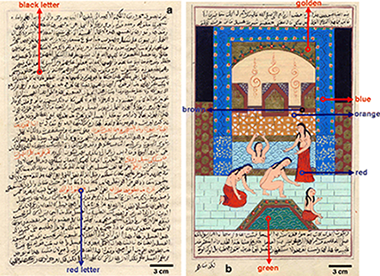
Abstract
Illuminated Arabic manuscripts have been studied, employing two laboratory-made X-ray diffraction (XRD) systems developed recently in the C2RMF laboratory. The validity of the µ-XRD and XRD portable systems for the study of this type of artworks has been demonstrated. A common observation in all the analyses is the presence of calcite and rutile; also, hematite, goethite, cinnabar, brass, anatase and barite were detected in the various colours. Differences between the results obtained by both techniques due to acquisition mode are discussed. In addition, other techniques such as X-ray fluorescence (XRF) and micro-Raman were used for the complete characterization of the manuscripts.
December, 2009 · DOI: 10.1007/s00216-009-2992-5
Study of metallic components of historical organ pipes using synchrotron radiation X-ray microfluorescence imaging and grazing incidence X-ray diffraction
Herrera, LK; Justo, A; Munoz-Paez, A; Sans, JA; Martinez-Criado, GAnalytical and Bioanalytical Chemistry, 395 (2009) 1969-1975 DOI: 10.1007/s00216-009-3075-3
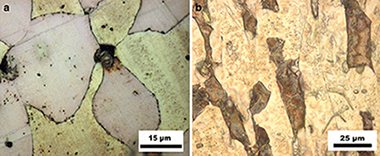
Abstract
A comparative study of the composition and microstructure of two different brass alloys from reed pipes, one from a Spanish baroque organ and the other from a modern one, was carried out. This study allowed us to determine the procedure followed to produce the brass used to make ancient reed pipes. Moreover the distribution and correlation of lead and other trace elements present into the main component of the brass, the copper and zinc phases, of the historical tongues and shallots were established. This chemical composition was compared with that of a tongue from a twentieth-century organ. The whole study was accomplished using a combination of laboratory and synchrotron radiation techniques. X-ray fluorescence was the technique used to obtain elemental and chemical imaging of the main phases and the trace elements at a sub-micrometer scale.
December, 2009 · DOI: 10.1007/s00216-009-3075-3
Materiales de Diseño para la Energía y Medioambiente
Reversibility of La and Lu sorption onto smectites: Implications for the design of engineered barriers in deep geological repositories
Galunin, E; Alba, MD; Aviles, MA; Santos, MJ; Vidal, MJournal of Hazardous Materials, 172 (2009) 1198-1205 DOI: 10.1016/j.jhazmat.2009.07.124
Abstract
The sorption reversibility of La and Lu (considered as actinide analogues) onto a set of smectites (bentonite FEBEX; hectorite, HEC; MX80; saponite, SAP; Otay montmorillonite, SCa-3; and Texas montmorillonite, STx-1) was studied to estimate actinide retention by smectites that are candidates for use as engineered barriers in deep geological repositories. The sorption distribution coefficients (K d) and the reversibility parameters (desorption distribution coefficients (K d,des), adjusted distribution coefficients (K d,adj), and desorption rates (R des)) were determined from batch tests in two ionic media: deionized water and Ca 0.02 mol L -1. The latter simulates possible conditions due to the presence of concrete leachates. The results varied greatly depending on the ionic medium, the lanthanide concentration and the clay structure. The high values of K d,des obtained (up to 1.1 × 10 5 and 9.2 × 10 4 L kg -1 for La and Lu in water, and 2.8 × 10 4 and 4.1 × 10 4 L kg -1 for La and Lu in the Ca medium) indicate the suitability of the tested smectites for lanthanide (and therefore, actinide) retention. Based on all the data, SCa-3, HEC and FEBEX clays are considered the best choices for water environments, whereas in Ca environments the suitable clays depended on the lanthanide considered.
December, 2009 · DOI: 10.1016/j.jhazmat.2009.07.124
Nanotecnología en Superficies y Plasma
Hybrid catalytic-DBD plasma reactor for the production of hydrogen and preferential CO oxidation (CO-PROX) at reduced temperatures
Rico, VJ; Hueso, JL; Cotrino, J; Gallardo, V; Sarmiento, B; Brey, JJ; Gonzalez-Elipe, ARChemical Communications, 41 (2009) 6192-6194 DOI: 10.1039/b909488a

Abstract
Dielectric Barrier Discharges (DBD) operated at atmospheric pressure and working at reduced temperatures (T < 115 °C) and a copper–manganese oxide catalyst are combined for the direct decomposition and the steam reforming of methanol (SRM) for hydrogen production and for the preferential oxidation of CO (CO-PROX)
November, 2009 · DOI: 10.1039/b909488a
Characterization of sepiolite-gel-based formulations for controlled release of pesticides
Maqueda, C; Partal, P; Villaverde, J; Perez-Rodriguez, JLApplied Clay Science, 46 (2009) 289-295 DOI: 10.1016/j.clay.2009.08.019
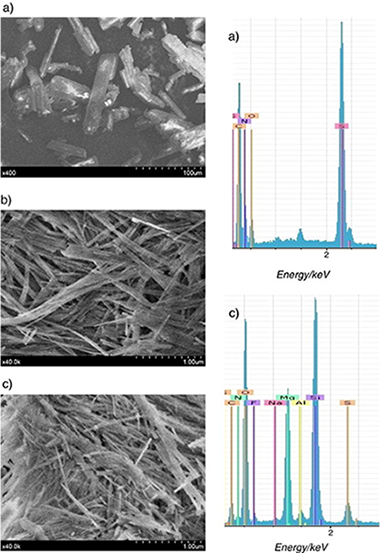
Abstract
Novel controlled release formulations (CRFs) were developed for reducing leaching of herbicides and contamination of groundwater. The herbicide metribuzin (MTB) was entrapped within a sepiolite-gel matrix using a novel and ultrasound-based technique. Different sepiolite/herbicide matrices (either as a gel or as a powder after freeze-drying) were prepared with pesticide loading between 28.6 and 9.1%. The release of MTB from the control released formulations into water was retarded when compared with commercial formulation (CF), except in the case of the sepiolite-gel-based formulations with lower amounts of sepiolite. The rheological properties and microstructure of these formulations were examined in detail. FTIR spectra showed that there was no evidence of herbicide inside the sepiolite tunnels. The SEM micrograph of the sepiolite-gel-based formulations showed the fibrous morphology typical of sepiolite and no separate particles of MTB were found. However, the chemical analysis by EDX confirmed the presence of S, N, and C, which were attributed to MTB, together with the fibers of sepiolite. Rheological characterization indicated that samples containing MTB develops a microstructure, which is irrespective of concentration above 1 mass % sepiolite. There was a good agreement between the microstructure characteristics and MTB release behavior.
November, 2009 · DOI: 10.1016/j.clay.2009.08.019
Materiales de Diseño para la Energía y Medioambiente
Synthesis and characterization of a plant cutin mimetic polymer
Heredia-Guerrero, JA; Heredia, A; Garcia-Segura, R; Benitez, JJPolymer, 50 (2009) 5633-5637 DOI: 10.1016/j.polymer.2009.10.018
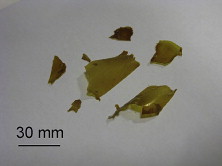
Abstract
A mimetic polymer of plant cutin have been synthesized from 9,10,16-trihydroxyhexadecanoic (aleuritic) acid through a low temperature polycondensation reaction. Reaction conditions (solvent, catalyst, temperature, etc…) were studied and modified to optimize yield and product characteristics. The resulting polyaleurate polymer was characterized by Attenuated Total Reflection-Fourier Transform Infrared Spectroscopy (ATR-FTIR), Differential Scanning Calorimetry (DSC), X-ray Diffraction (XRD) and solid state 13C-Cross Polarization/Magic Angle Spinning Nuclear Magnetic Resonance (13C-CP/MAS NMR). Mechanical and hydrodynamic properties were also investigated. In the average, the product obtained is physically and chemically very similar to plant cutin (a hydrophobic polyester). However, a more detailed analysis of results reveals that polyaleurate framework is more rigid than natural cutin and with additional larger short-range ordered domains. Also, the synthetic polymer displays slightly different mechanical properties with respect to natural cutin. Additional hydrogen bonding within the framework of polyaleurate is considered to be responsible for such experimental observations.
November, 2009 · DOI: 10.1016/j.polymer.2009.10.018
Materiales Nanoestructurados y Microestructura
Bonding Structure and Mechanical Properties of Ti-B-C Coatings
Abad, MD; Caceres, D; Pogozhev, YS; Shtansky, DV; Sanchez-Lopez, JCPlasma Processes and Polymers, 6 (2009) S107-S112 DOI: 10.1002/ppap.200930403
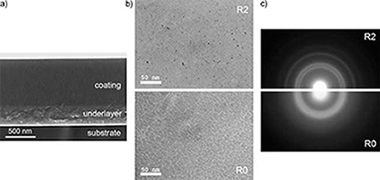
Abstract
Nanocomposite coatings combining hard phases (TiB2, TiC) with an amorphous carbon (a-C) were developed to provide a good compromise between mechanical and tribological properties for M2 steels used in a wide variety of applications such as cutting tools, bearings and gear mechanisms. A combined d.c.-pulsed and r.f.-magnetron deposition process was used to deposit nanocomposite TiBC/a-C coatings with a variable content of carbon matrix phase. Chemical composition was determined by electron energy loss spectroscopy (EELS) and X-ray photoelectron spectroscopy (XPS). Transmission electron microscopy (TEM) revealed that the coatings microstructure is rather amorphous with small nanocrystals of TiC and/or TiB2 (not possible to differentiate by diffraction techniques). Investigation of the chemical bonding environment by XPS and EELS allows us to confirm the presence of titanium-boron and titanium-carbon bonds together with free a-C. Coatings exhibited hardness values (H) of 25–29 GPa, effective Young modulus (E*) of 310–350 GPa, H/E* ratios over 0.080 and resistance to plastic deformation (H3/E*2) from 0.15 to 0.20. Tribological properties of the coatings were characterized by a pin-on-disk tribometer using steel and WC balls at high contact stresses (1.1 and 1.4 GPa respectively). Friction coefficients were reduced from 0.6 to 0.2 by increasing the content of free carbon without reduction of the hardness (around 28 GPa), by self-lubricant effects. The tribo-mechanical data are revised according to the phase composition and chemical bonding inside the nanocomposites.
November, 2009 · DOI: 10.1002/ppap.200930403
Materiales de Diseño para la Energía y Medioambiente
The hydrothermal conversion of kaolinite to kalsilite: Influence of time, temperature, and pH
Becerro, AI; Escudero, A; Mantovani, MAmerican Mineralogist, 94 (2009) 11-12 DOI: 10.2138/am.2009.3284
Abstract
Kalsilite (the low-temperature form of KAlSiO4) is used as the precursor of leucite, an important component in porcelain-fused-to-metal and ceramic-restoration systems, and it has also been proposed as a high-thermal expansion ceramic for bonding to metals. The present study reports the hydrothermal synthesis and characterization of pure kalsilite from kaolinite in subcritical conditions, as well as the characterization of the intermediate products by means of XRD, 29Si and 27Al MAS NMR, IR, SEM, and TEM. Effects of time, temperature, and pH on the reaction products are analyzed. The experimental data indicate that pure kalsilite is obtained after hydrothermal treatment of kaolinite at 300 °C for 12 h in 0.5 M KOH solution. Longer reaction times increase the crystallinity of the structure, whereas lower reaction times give rise to the metastable ABW-type KAlSiO4 polymorph. Lower temperatures are not sufficient to produce kalsilite, but zeolite W is obtained instead as the unique reaction product. Finally, the pH of the aqueous solution in contact with kaolinite is an important parameter for the synthesis of kalsilite, which must be ≥13.70.
November, 2009 · DOI: 10.2138/am.2009.3284
Advanced combined application of μ-X-ray diffraction/μ-X-ray fluorescence with conventional techniques for the identification of pictorial materials from Baroque Andalusia paintings
Herrera, LK; Montalbani, S; Chiavari, G; Cotte, M; Sole, VA; Bueno, J; Duran, A; Justo, A; Perez-Rodriguez, JLTalanta, 80 (2009) 71-83 DOI: 10.1016/j.talanta.2009.06.032
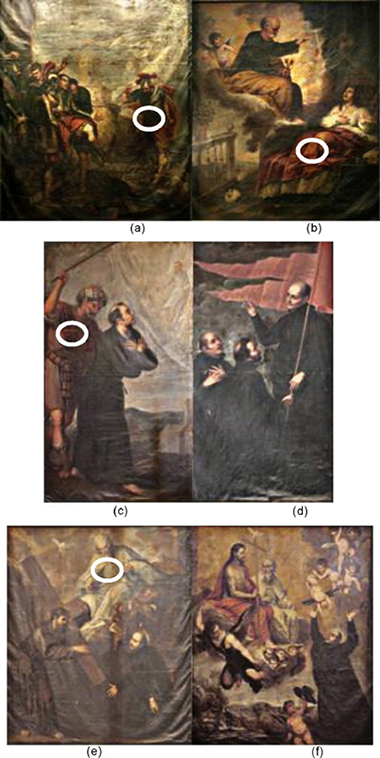
Abstract
The process of investigating paintings includes the identification of materials to solve technical and historical art questions, to aid in the deduction of the original appearance, and in the establishment of the chemical and physical conditions for adequate restoration and conservation. In particular, we have focused on the identification of several samples taken from six famous canvases painted by Pedro Atanasio Bocanegra, who created a very special collection depicting the life of San Ignacio, which is located in the church of San Justo y Pastor of Granada, Spain. The characterization of the inorganic and organic compounds of the textiles, preparation layers, and pictorial layers have been carried out using an XRD diffractometer, SEM observations, EDX spectrometry, FT-IR spectrometry (both in reflection and transmission mode), pyrolysis/gas chromatography/mass spectrometry and synchrotron-based μ-X-ray techniques. In this work, the advantages over conventional X-ray diffraction of using combined synchrotron-based μ-X-ray diffraction and μ-X-ray fluorescence in the identification of multi-layer paintings is demonstrated.
November, 2009 · DOI: 10.1016/j.talanta.2009.06.032
Química de Superficies y Catálisis
Self-Assembling of Er2O3-TiO2 Mixed Oxide Nanoplatelets by a Template-Free Solvothermal Route
Julian-Lopez, B; Martos, M; Ulldemolins, N; Odriozola, JA; Cordoncillo, E; Escribano, PChemistry-A European Journal, 15 (2009) 12426-12434 DOI: 10.1002/chem.200901423
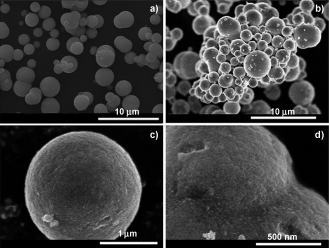
Abstract
An easy solvothermal route has been developed to synthesize the first mesoporous Er2O3-TiO2 mixed oxide spherical particles composed of crystalline nanoplatelets, with high surface area and narrow pore size distribution. This synthetic strategy allows the preparation of materials at low temperature with interesting textural properties without the use of surfactants, as well as the control of particle size and shape. TEM and Raman analysis confirm the formation of nanocrystalline Er2O 3-TiO2 mixed oxide. Mesoscopic ordered porosity is reached through the thermal decomposition of organic moieties during the synthetic process, thus leading to a template-free methodology that can be extended to other nanostructured materials. High specific surface areas (up to 313 m 2g-1) and narrow pore size distributions are achieved in comparison to the micrometric material synthesized by the traditional sol-gel route. This study opens new perspectives in the development, by solvothermal methodologies, of multifunctional materials for advanced applications by improving the classical pyrochlore properties (magnetization, heat capacity, catalysis, conductivity, etc.). In particular, since catalytic reactions take place on the surface of catalysts, the high surface area of these materials makes them promising candidates for catalysts. Furthermore, their spherical morphology makes them appropriate for advanced technologies in, for instance, ceramic inkjet printers.
November, 2009 · DOI: 10.1002/chem.200901423
Química de Superficies y Catálisis
Methane steam reforming in a microchannel reactor for GTL intensification: A computational fluid dynamics simulation study
Arzamendia, G; Dieguez, PM; Montes, M; Odriozola, JA; Sousa-Aguiar, EF; Gandia, LMChemical Engineering Journal, 154 (2009) 168-173 DOI: 10.1016/j.cej.2009.01.035

Abstract
The integration of the steam reforming and combustion of methane in a catalytic microchannel reactor has been simulated by computational fluid dynamics (CFD). Two models including 4 or 20 square microchannels of 20 mm of length and 0.7 mm of side have been developed. It has been assumed that a thin and homogeneous layer of an appropriate catalyst has been uniformly deposited onto the channels walls. The kinetics of the steam reforming of methane (SRM), water-gas shift (WGS) and methane combustion in air have been incorporated into the models. This has allowed simulating the effect of the gas streams space velocities, catalyst load, steam-to-carbon (S/C) ratio and flow arrangement on the microreformer performance. The results obtained illustrate the potential of microreactors for process intensification: complete combustion of methane is achieved at gas hourly space velocities (GHSV) as high as 130,000 h−1. As concerns the SRM, methane conversions above 97% can be obtained at high GHSV of 30,000 h−1 and temperatures of 900–950 °C. Under these conditions selectivity for syngas is controlled by the WGS equilibrium.
November, 2009 · DOI: 10.1016/j.cej.2009.01.035
Química de Superficies y Catálisis
Ionic liquid templated TiO2 nanoparticles as a support in gold environmental catalysis
Avellaneda, RS; Ivanova, S; Sanz, O; Romero-Sarria, F; Centeno, MA; Odriozola, JAApplied Catalysis B-Environmental, 93 (2009) 140-148 DOI: 10.1016/j.apcatb.2009.09.023

Abstract
This work presents the synthesis of a nanostructured titania support and its subsequent utilization for the gold particles deposition and application in the reaction of the CO oxidation. A functionalized ionic liquid has been used as a templating agent for the titanium oxide synthesis resulting in a high specific surface nanostructured titania anatase. The as prepared support was then used for gold nanoparticles deposition without ionic liquid removal in order to study the possible role of the latter in the stabilization of the gold particles. The presence of ionic liquid in the catalysts results in an unusual catalytic behaviour—strong dependence on the presence of CO and changed kinetics and rate of oxidation.
November, 2009 · DOI: 10.1016/j.apcatb.2009.09.023
Reactividad de Sólidos
Combined kinetic analysis of thermal degradation of polymeric materials under any thermal pathway
Sanchez-Jimenez, PE; Perez-Maqueda, LA; Perejon, A; Criado, JMPolymer Degradation and Stability, 94 (2009) 2079-2085 DOI: 10.1016/j.polymdegradstab.2009.07.006
Abstract
Combined kinetic analysis has been applied for the first time to the thermal degradation of polymeric materials. The combined kinetic analysis allows the determination of the kinetic parameters from the simultaneous analysis of a set of experimental curves recorded under any thermal schedule. The method does not make any assumptions about the kinetic model or activation energy and allows analysis even when the process does not follow one of the ideal kinetic models already proposed in the literature. In the present paper the kinetics of the thermal degradation of both polytetrafluoroethylene (PTFE) and polyethylene (PE) have been analysed. It has been concluded, without previous assumptions on the kinetic model, that the thermal degradation of PTFE obeys a first order kinetic law, while the thermal degradation of PE follows a diffusion-controlled kinetic model.
November, 2009 · DOI: 10.1016/j.polymdegradstab.2009.07.006
Materiales de Diseño para la Energía y Medioambiente
Hydrothermal Synthesis of Kalsilite: A Simple and Economical Method
Becerro, AI; Mantovani, M; Escudero, AJournal of the American Ceramic Society, 92 (2009) 2204-2206 DOI: 10.1111/j.1551-2916.2009.03232.x
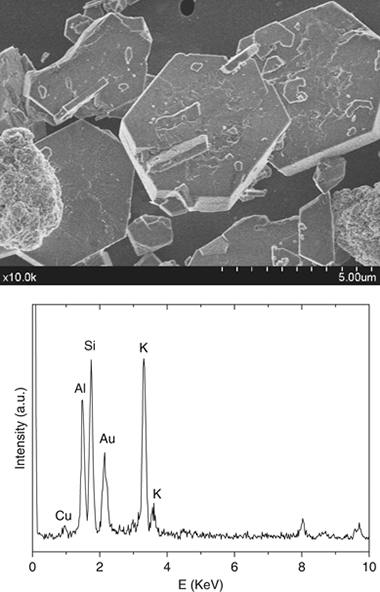
Abstract
This study reports a simple method to synthesize pure kalsilite (KAlSiO4) using readily available precursors, kaolinite and KOH solution, after only 12 h of hydrothermal treatment in mild conditions. A structural refinement has been carried out using the Rietveld method to obtain unit cell parameters, and the 29Si and 27Al magic angle spinning nuclear magnetic resonance spectra have shown the purity and complete Si/Al ordering of the kalsilite structure obtained. Finally, the morphology of the particles has been analyzed by scanning electron microscopy.
October, 2009 · DOI: 10.1111/j.1551-2916.2009.03232.x
Materiales Ópticos Multifuncionales
Optical Analysis of the Fine Crystalline Structure of Artificial Opal Films
Lozano, G; Dorado, LA; Schinca, D; Depine, RA; Miguez, HLangmuir, 25 (2009) 12860-12864 DOI: 10.1021/la903077r
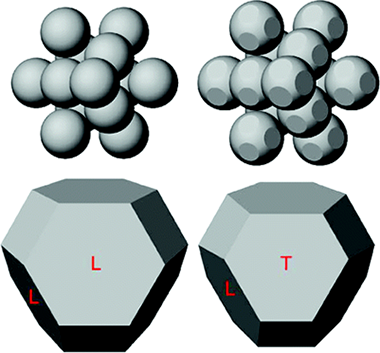
Abstract
Herein, we present a detailed analysis of the structure of artificial opal films. We demonstrate that, rather than the generally assumed face centered cubic lattice of spheres, opal films are better approximated by rhombohedral assemblies of distorted colloids. Detailed analysis of the optical response in a very wide spectral range (0.4 ≤ a/λ ≤ 2, where a is the conventional lattice constant), as well as at perpendicular and off-normal directions, unambiguously shows that the interparticle distance coincides very approximately with the expected diameter only along directions contained in the same close-packed plane but differs significantly in directions oblique to the [111] one. A full description of the real and reciprocal lattices of actual opal films is provided, as well as of the photonic band structure of the proposed arrangement. The implications of this distortion in the optical response of the lattice are discussed.
October, 2009 · DOI: 10.1021/la903077r
Hg/Sn amalgam degradation of ancient glass mirrors
Herrera, LK; Duran, A; Franquelo, ML; Justo, A; Perez-Rodriguez, JLJournal of Non-Crystalline Solids, 355 (2009) 1980-1983 DOI: 10.1016/j.jnoncrysol.2008.11.045
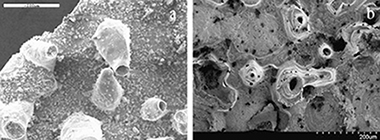
Abstract
Tin amalgam, which is obtained by pouring mercury onto a sheet of tin, has been used in the production of reflective coatings for mirrors. The corrosion processes of the amalgam layer were investigated in several mirrors from historical buildings located in southern Spain using SEM/EDS, XPS, and GID. Mercury and Sn4+ are present as spheres on the amalgam surface due to the evaporation process (∼5 nm). The profile shows a mixture of Sn2+ and Sn4+. The original amalgam was composed of a binary alloy of tin and mercury (Hg0.1Sn0.9) and metallic tin. In this paper the tin oxidation mechanism of the amalgam is described. Liquid mercury is volatile and evaporates slowly, leaving fine tin particles that oxidize easily, forming tin monoxide (SnO) and tin dioxide (SnO2). The mercury-rich phase accelerates the corrosion of the tin-rich phase.
October, 2009 · DOI: 10.1016/j.jnoncrysol.2008.11.045
Química de Superficies y Catálisis - Materiales Nanoestructurados y Microestructura
Manganese and iron oxides as combustion catalysts of volatile organic compounds
Duran, FG; Barbero, BP; Cadus, LE; Rojas, C; Centeno, MA; Odriozola, JAApplied Catalysis B-Environmental, 92 (2009) 194-201 DOI: 10.1016/j.apcatb.2009.07.010
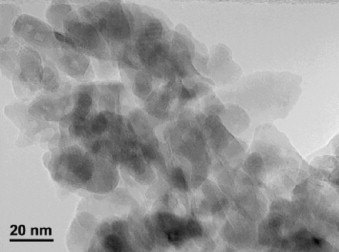
Abstract
FeMn mixed oxides were prepared by the citrate method with Fe:Mn atomic ratio equal to 1:1, 1:3 and 3:1. The sample was characterized by means of specific surface area measurements, X-ray diffractometry (XRD), temperature programmed desorption of oxygen (O2-DTP), temperature programmed reduction (TPR), X-ray fluorescence (XRF), transmission electron microscopy (TEM and SAED) and high resolution TEM (HREM). The characterization results demonstrated the formation of a Mn2O3–Fe2O3 solid solution. The catalytic performance in ethanol, ethyl acetate and toluene total oxidation on these samples was better than on Fe2O3 and Mn2O3 pure oxides.
October, 2009 · DOI: 10.1016/j.apcatb.2009.07.010
Materiales Ópticos Multifuncionales
Mesostructured Thin Films as Responsive Optical Coatings of Photonic Crystals
Hidalgo, N; Calvo, ME; Miguez, HSmall, 5 (2009) 2309-2315 DOI: 10.1002/smll.200900411
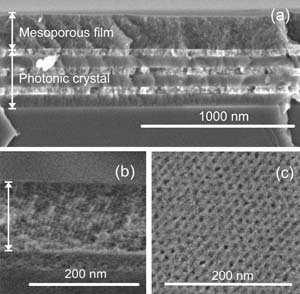
Abstract
A synthetic route is presented to attain high-optical-quality multilayered structures that residtfront coupling ordered n7esoporous tilaniuni oxide thin films to the surface of a dense one-dimensional photonic crystal. Such architectures present spectrally well-defined photon resonant modes localized in the outer coating that finely respond to physicochemically induced modifications of its pore volume. The potential of these porous coatings in detection of environmental changes through variations of the photonic response of the ensemble is demonstrated by performing isothermal optical reflectance measurements under controlled vapor-pressure conditions.
October, 2009 · DOI: 10.1002/smll.200900411
Nanotecnología en Superficies y Plasma - Materiales Nanoestructurados y Microestructura
Vibrational spectroscopy characterization of magnetron sputtered silicon oxide and silicon oxynitride films
Godinho, V; Denisov, VN; Mavrin, BN; Novikova, NN; Vinogradov, EA; Yakovlev, VA; Fernandez-Ramos, C; de Haro, MCJ; Fernandez, AApplied Surface Science, 256 (2009) 156-164 DOI: 10.1016/j.apsusc.2009.07.101

Abstract
Vibrational (infrared and Raman) spectroscopy has been used to characterize SiOxNy and SiOx films prepared by magnetron sputtering on steel and silicon substrates. Interference bands in the infrared reflectivity measurements provided the film thickness and the dielectric function of the films. Vibrational modes bands were obtained both from infrared and Raman spectra providing useful information on the bonding structure and the microstructure (formation of nano-voids in some coatings) for these amorphous (or nanocrystalline) coatings. X-ray photoelectron spectroscopy (XPS) and scanning electron microscopy (SEM) analysis have also been carried out to determine the composition and texture of the films, and to correlate these data with the vibrational spectroscopy studies. The angular dependence of the reflectivity spectra provides the dispersion of vibrational and interference polaritons modes, what allows to separate these two types of bands especially in the frequency regions where overlaps/resonances occurred. Finally the attenuated total reflection Fourier transform infrared measurements have been also carried out demonstrating the feasibility and high sensitivity of the technique. Comparison of the spectra of the SiOxNy films prepared in various conditions demonstrates how films can be prepared from pure silicon oxide to silicon oxynitride with reduced oxygen content.
October, 2009 · DOI: 10.1016/j.apsusc.2009.07.101
Materiales de Diseño para la Energía y Medioambiente
Rare-earth disilicate formation under Deep Geological Repository approach conditions
Alba, MD; Chain, P; Orta, MMApplied Clay Science, 46 (2009) 63-68 DOI: 10.1016/j.clay.2009.07.012

Abstract
The Deep Geological Repository (DGR) concept involves the placement of long-lived radioactive waste in rooms excavated deep. The major responsibility of the disposal safety falls on the Engineered Barrier System (EBS). The main constituent of EBS is bentonite that prevents the release of radiactive nuclei by physical and chemical mechanisms. The physical mechanism is expected to fault with the weathering of the bentonite while the chemical mechanisms have been only proved at 300 °C. It is the aim of this paper to explore the feasibility of the chemical mechanism at temperatures closer to the DGP conditions and to shed light on the mechanism of transformation of the argillaceous materials of the EBS in rare-earth disilicate phases. Saponite was submitted to hydrothermal reaction at 175 °C and 150 °C with different solutions of REE3+ cations (REE = Sc, Lu, Y, Sm, Nd and La). The products were analyzed by XRD, NMR and electron microscopy. At conditions close to the DGP, the saponite was able to form rare-earth silicates. The formation of the disilicate phase, as final product, needs a set of stages and oxyorthosilicate as precursor.
September, 2009 · DOI: 10.1016/j.clay.2009.07.012
Nanotecnología en Superficies y Plasma
Formation of Nitrogen Functional Groups on Plasma Treated DLC
Lopez-Santos, C; Yubero, F; Cotrino, J; Contreras, L; Barranco, A; Gonzalez-Elipe, ARPlasma Processes and Polymers, 6 (2009) 555-565 DOI: 10.1002/ppap.200900019

Abstract
Diamond like carbon (DLC) thin films have been exposed to different nitrogen containing plasmas. A dielectric barrier discharge (DBD) at atmospheric pressure and a microwave discharge (MW) at low pressure using N2 and mixtures Ar + NH3 have been compared. Optical Emission and X-ray Photoelectron spectroscopies, Atomic Force Microscopy and contact angle measurements have been used for this study. A DBD with Ar + NH3 is the most efficient method for DLC functionalization. Films treated with this plasma presented the highest concentration of amine groups as determined by derivatization with 4-chlorobenzaldehyde. All the treated samples underwent a significant aging with time. The efficiency of the different plasmas for DLC functionalization is discussed in the light of the intermediate species detected in the plasma.
September, 2009 · DOI: 10.1002/ppap.200900019
Materiales Nanoestructurados y Microestructura
Comparative investigation of TiAlC(N), TiCrAlC(N), and CrAlC(N) coatings deposited by sputtering of МАХ-phase Ti2 − хCrхAlC targets
Shtansky, DV; Kiryukhantsev-Korneev, PV; Sheveyko, AN; Mavrin, BN; Rojas, C; Fernandez, A; Levashov, EASurface and Coatings Technology, 203 (2009) 3595-3609 DOI: 10.1016/j.surfcoat.2009.05.036

Abstract
A comparative investigation of the structure and properties of TiAlC(N), TiCrAlC(N), and CrAlC(N) coatings deposited by sputtering of МАХ-phase Ti2 − хCrхAlC targets (where x = 0, 0.5, 1.5, and 2) in an Ar atmosphere or in a gaseous mixture of Ar + N2 is presented. The coatings were characterized in terms of their structure, elemental and phase composition, hardness, elastic modulus, elastic recovery, thermal stability, friction coefficient, wear rate, corrosion, and high-temperature oxidation resistance. The structure of the coatings was studied by means of X-ray diffraction, scanning and transmission electron microscopy, X-ray photoelectron spectroscopy, glow discharge optical emission spectroscopy, electron energy loss spectroscopy, and Raman spectroscopy. To evaluate the thermal stability and oxidation resistance, the coatings were annealed either in vacuum or in air at temperatures 600–1200 °C. The results obtained show that the TiAlCN coatings possess high hardness of 32–35 GPa, low friction coefficient against WC–Co well below 0.25, high thermal stability up to 1200 °C, and superior performance in dry milling tests against high Cr steel. Meanwhile, the coatings with high Cr content demonstrated improved oxidation resistance up to 1000 °C and superior electrochemical behavior, but their mechanical and tribological properties were deteriorated.
August, 2009 · DOI: 10.1016/j.surfcoat.2009.05.036
Materiales y Procesos Catalíticos de Interés Ambiental y Energético
Reactivity of LaNi1−y Co y O3−δ Perovskite Systems in the Deep Oxidation of Toluene
Pereniguez, R; Hueso, JL; Holgado, JP; Gaillard, F; Caballero, ACatalysis Letters, 131 (2009) 164-169 DOI: 10.1007/s10562-009-9968-0

Abstract
In the present work we have evaluated the oxidation of toluene over different lanthanum perovskites with a general composition of LaNi1−y Co y O3−δ. These catalysts, prepared by a spray pyrolysis method, have been characterised by XRD, BET and FE-SEM techniques. Additional experiments of temperature programmed desorption of O2, reduction in H2 and X-ray absorption spectroscopy were also performed in order to identify the main surface oxygen species and the reducibility of the different perovskites. The catalytic behaviour toward the oxidation of toluene (as a model for VOCs compounds) was evaluated in the range 100–600 °C, detecting a total conversion for all the samples below 400 °C and higher activities for the cobalt-containing perovskites. The catalytic behaviour of these samples is consistent with a suprafacial mechanism, with the α-type oxygen playing an active role in the oxidation reaction.
August, 2009 · DOI: 10.1007/s10562-009-9968-0
Materiales y Procesos Catalíticos de Interés Ambiental y Energético
Structural characteristics and morphology of SmxCe1−xO2−x/2 thin films
Hartmanova, M; Jergel, M; Mansilla, C; Holgado, JP; Zemek, J; Jurek, K; Kundracik, FApplied Surface Science, 255 (2009) 9085-9091 DOI: 10.1016/j.apsusc.2009.06.108

Abstract
Effect of the deposition temperature (200 and 500 °C) and composition of SmxCe1−xO2−x/2 (x = 0, 10.9–15.9 mol%) thin films prepared by electron beam physical vapor deposition (EB-PVD) and Ar+ ion beam assisted deposition (IBAD) combined with EB-PVD on structural characteristics and morphology/microstructure was investigated. The X-ray photoelectron spectroscopy (XPS) of the surface and electron probe microanalysis (EPMA) of the bulk of the film revealed the dominant occurrence of Ce4+ oxidation state, suggesting the presence of CeO2 phase, which was confirmed by X-ray diffraction (XRD). The Ce3+ oxidation states corresponding to Ce2O3 phase were in minority. The XRD and scanning electron microscopy (SEM) showed the polycrystalline columnar structure and a rooftop morphology of the surface. Effects of the preparation conditions (temperature, composition, IBAD) on the lattice parameter, grain size, perfection of the columnar growth and its impact on the surface morphology are analyzed and discussed.
August, 2009 · DOI: 10.1016/j.apsusc.2009.06.108
Materiales Nanoestructurados y Microestructura
Chemical and electronic interface structure of spray pyrolysis deposited undoped and Al-doped ZnO thin films on a commercial Cz-Si solar cell substrate
Gabas, M; Barrett, NT; Ramos-Barrado, JR; Gota, S; Rojas, TC; Lopez-Escalante, MCSolar Energy Materials and Solar Cells, 93 (2009) 1356-1365 DOI: 10.1016/j.solmat.2009.02.018
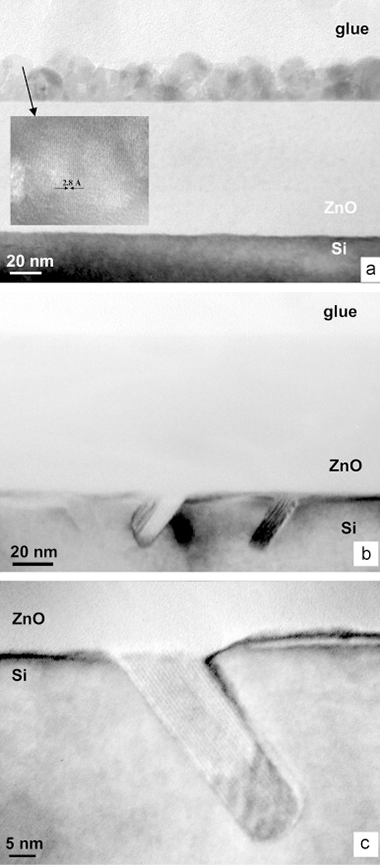
Abstract
We have studied differences in the interface between undoped and Al-doped ZnO thin films deposited on commercial Si solar cell substrates. The undoped ZnO film is significantly thicker than the Al-doped film for the same deposition time. An extended silicate-like interface is present in both samples. Transmission electron microscopy (TEM) and photoelectron spectroscopy (PES) probe the presence of a zinc silicate and several Si oxides in both cases. Although Al doping improves the conductivity of ZnO, we present evidence for Al segregation at the interface during deposition on the Si substrate and suggest the presence of considerable fixed charge near the oxidized Si interface layer. The induced distortion in the valence band, compared to that of undoped ZnO, could be responsible for considerable reduction in the solar cell performance.
August, 2009 · DOI: 10.1016/j.solmat.2009.02.018
Nanotecnología en Superficies y Plasma
Identification of hydrogen and deuterium at the surface of water ice by reflection electron energy loss spectroscopy
Yubero, F; Tokesi, KApplied Physics Letters, 95 (2009) 084101 DOI: 10.1063/1.3202402

Abstract
A nondestructive method to distinguish between hydrogen (H) and deuterium (D) at surfaces by reflection electron energy loss spectroscopy is presented. It is based on the analysis of the energy distributions of electrons elastically backscattered from surfaces containing H or D. We consider standard and deuterated water ices as test surfaces. The recoil energy of the backscattered electrons depends on the atomic mass of the targets, and the contributions of H, D, and O to the measured spectra can be easily separated. The results of Monte Carlo simulations corroborate the experimental findings.
August, 2009 · DOI: 10.1063/1.3202402
Reactividad de Sólidos
High surface area α-alumina preparation by using urban waste
Martin-Ruiz, MM; Perez-Maqueda, LA; Cordero, T; Balek, V; Subrt, J; Murafa, N; Pascual-Cosp, JCeramics International, 35 (2009) 2111-2117 DOI: 10.1016/j.ceramint.2008.11.011
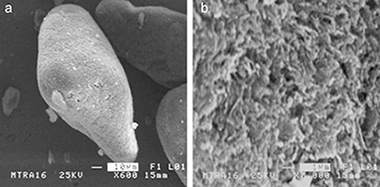
Abstract
A new method for preparing high surface area α-alumina from urban waste is proposed. The method consists of the precipitation of a precursor that contains bohemite mixed with a linear polymer and subsequently the thermal decomposition of the precursor by heating in nitrogen and air to 1200 °C. The resulting α-alumina consists of nanocrystals of about 100 nm aggregated into larger particles with relatively high surface area (12 m2 g−1) and a significant macropore volume of 0.545 cm3 g. Methods of X-ray diffraction (XRD), scanning electron microscopy (SEM), high-resolution transmission electron microscopy (HRTEM) and selected area electron diffraction (SAED) were used to characterize microstructure of prepared materials. Results of differential thermal analysis, thermogravimetry and emanation thermal analysis characterized the thermal behaviour of α-alumina precursors.
August, 2009 · DOI: 10.1016/j.ceramint.2008.11.011
Materiales Coloidales
Synthesis by pyrolysis of aerosols and ceramic application of Cr-doped CaYAlO4 red–orange pigments
Lyubenova, TS; Carda, JB; Ocana, MJournal of the European Ceramic Society, 29 (2009) 2193-2198 DOI: 10.1016/j.jeurceramsoc.2009.01.020

Abstract
The synthesis of red–orange Cr-doped YCaAlO4 pigments has been improved (softer thermal conditions and lower environmental impact) and optimised by using the pyrolysis of aerosols method. We also study the crystallochemical features of the Cr chromophore with special emphasis on its oxidation state which has not been yet clarified, finding that Cr(III) and Cr(IV) species are present in the octahedral and interstitial tetrahedral sites of the YCaAlO4 lattice, respectively. Finally, the applicability of this system as ceramic pigment was tested using conventional industrial glazes. A change from orange to pink shades was detected after glaze firing, which is mainly attributed to the Cr3+ to Cr4+ oxidation.
August, 2009 · DOI: 10.1016/j.jeurceramsoc.2009.01.020
Fotocatálisis Heterogénea: Aplicaciones
Influence of sulfur on the structural, surface properties and photocatalytic activity of sulfated TiO2
Colon, G; Hidalgo, MC; Navio, JA; Kubacka, A; Fernandez-Garcia, MApplied Catalysis B-Environmental, 90 (2009) 633-641 DOI: 10.1016/j.apcatb.2009.04.026
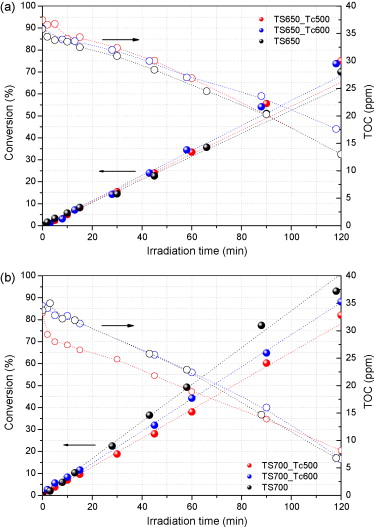
Abstract
TiO2 materials were prepared by sol–gel method and then impregnated with sulfuric acid and calcined using different temperatures and atmosphere (air and nitrogen). Systematic variation of these two experimental parameters makes possible to modulate the amount of surface sulfur from the impregnation procedure. The best photocatalyst for liquid phenol degradation was obtained after calcination at 700 °C in air, while gas toluene degradation optimum performance is obtained by calcination at 700 °C in nitrogen from 500 °C. Structural analysis of these materials by XRD, micro-Raman spectroscopy and FE-SEM shows that once calcined at 700 °C the material was a well-crystallized, high surface area anatase structure in all cases. The surface characterization by FTIR and XPS confirms the presence of a higher amount of sulfur species and acidic OH groups in samples partially calcined in nitrogen, and a low XPS O/Ti-atomic ratio with the O 1s peak shifted to higher binding energies (1.8 vs. 2 ± 0.1 and 530.4 eV vs. 529.8 eV, respectively, against the reference materials) for samples calcined at 700 °C, temperature at which most of sulfate species have been evolved. The paper presents an attempt to correlate the contribution of the observed structural defects within the anatase sub-surface layers and surface acidity to the different photoactivity behaviour exhibited for phenol liquid phase and toluene gas phase photodegradation.
August, 2009 · DOI: 10.1016/j.apcatb.2009.04.026
Materiales de Diseño para la Energía y Medioambiente
Mineralogical stability of phyllosilicates in hyperalkaline fluids: Influence of layer nature, octahedral occupation and presence of tetrahedral Al
Becerro, AI; Mantovani, M; Escudero, AAmerican Mineralogist, 94 (2009) 1187-1197 DOI: 10.2138/am.2009.3164
Abstract
Mineralogical changes in a set of phyllosilicates, differing in their layer nature, chemical composition, octahedral character, and Al content of the tetrahedral sheet, were analyzed after hydrothermal reaction in an alkaline solution. The composition of the alkaline solution was selected to simulate the first stage of cement degradation [NaOH-KOH-Ca(OH)2]. The reaction products have been analyzed by XRD, 29Si and 27Al MAS NMR spectroscopy, SEM/EDX, and TEM. The results indicate that the main factor influencing the stability of the clays is the occupation of the octahedral sheet such that all trioctahedral members withstand the alkaline attack, whereas most of the dioctahedral clays suffer a complete dissolution and crystallization of new phases. Second, clays with Al in the tetrahedral sheet of their layers are shown to be less stable than those with a pure Si tetrahedral sheet.
August, 2009 · DOI: 10.2138/am.2009.3164
Reactividad de Sólidos - Fotocatálisis Heterogénea: Aplicaciones
Kinetics of the thermal decomposition of anhydrous cobalt nitrate by SCRT method
Ortega, A; Macias, M; Gotor, FJJournal of Thermal Analysis and Calorimetry, 98 (2009) 441-448 DOI: 10.1007/s10973-009-0322-y
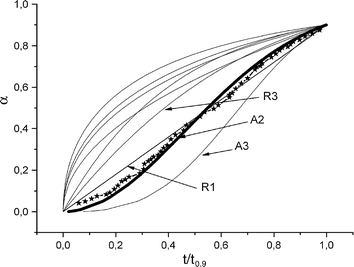
Abstract
It has been shown the ability of the Sample Controlled Reaction Temperature (SCRT) method for both discriminate the kinetic law and calculate the activation energy of the reaction. This thermal decomposition is best described by a Johnson–Mehl–Avrami kinetic model (with n = 2) with an activation energy of nuclei growth which fall in the range 52–59 kJ mol−1. The process is not a single-step because the initial rate of decomposition is likely to be limited by nucleation. The results reported here constitute the first attempt to use the new SCRT method to study the kinetic of the thermal decomposition of cobalt nitrate.
August, 2009 · DOI: 10.1007/s10973-009-0322-y
Nanotecnología en Superficies y Plasma - Materiales y Procesos Catalíticos de Interés Ambiental y Energético
Near-ambient X-ray photoemission spectroscopy and kinetic approach to the mechanism of carbon monoxide oxidation over lanthanum substituted cobaltites
Hueso, JL; Martinez-Martinez, D; Caballero, A; Gonzalez-Elipe, AR; Mun, BS; Salmeron, MCatalysis Communications, 10 (2009) 1898-1902 DOI: 10.1016/j.catcom.2009.06.022
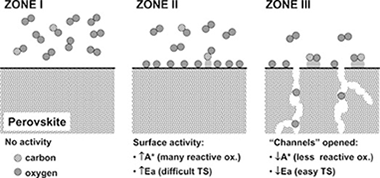
Abstract
We have studied the oxidation of carbon monoxide over a lanthanum substituted perovskite (La0.5Sr0.5CoO3−d) catalyst prepared by spray pyrolysis. Under the assumption of a first-order kinetics mechanism for CO, it has been found that the activation energy barrier of the reaction changes from ∼80 to ∼40 kJ mol−1 at a threshold temperature of ca. 320 °C. In situ XPS near-ambient pressure (∼0.2 torr) shows that the gas phase oxygen concentration over the sample decreases sharply at ca. 300 °C. These two observations suggest that the oxidation of CO undergoes a change of mechanism at temperatures higher than 300 °C.
August, 2009 · DOI: 10.1016/j.catcom.2009.06.022
Reactividad de Sólidos
Synthesis of complex carbonitride powders TiyMT1−yCxN1−x (MT: Zr, V, Ta, Hf) via a mechanically induced self-sustaining reaction
Cordoba, JM; Aviles, MA; Sayagues, MJ; Alcala, MD; Gotor, FJJournal of Alloys and Compounds, 482 (2012) 349-355 DOI: 10.1016/j.jallcom.2009.04.012
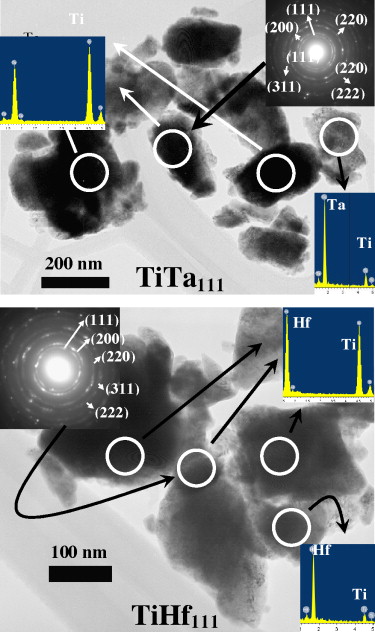
Abstract
The machinability of materials is a dynamic field with enormous implications in different industrial sectors because manufacturers are constantly looking for improvements that can increase the overall productivity. Manufacturers of cutting tool inserts need to develop products that can perform at higher speeds and last longer under increasingly rigorous operating conditions. It has been revealed that cermets may exhibit better properties and performances when solid solution of multiple hard compounds is added instead of a mixture of several binary ones. In this work, a mechanically induced self-sustaining reaction (MSR) is described as a suitable synthesis method to obtain a wide range of different new quaternary carbonitride systems by milling mixtures of elemental powders of transition metals and graphite in a nitrogen atmosphere. Characterization was carried out using X-ray powder diffraction, elemental analysis, energy dispersive X-ray analysis (EDX), scanning and transmission electron microscopy and electron diffraction (ED).
August, 2009 · DOI: 10.1016/j.jallcom.2009.04.012
Nanotecnología en Superficies y Plasma
Incorporation and Thermal Evolution of Rhodamine 6G Dye Molecules Adsorbed in Porous Columnar Optical SiO2 Thin Films
Sanchez-Valencia, JR; Blaszczyk-Lezak, I; Espinos, JP; Hamad, S; Gonzalez-Elipe, AR; Barranco, ALangmuir, 25 (2009) 6869-6874 DOI: 10.1021/la900695t

Abstract
Rhodamine 6G (Rh6G) dye molecules have been incorporated into transparent and porous SiO2 thin films prepared by evaporation at glancing angles. The porosity of these films has been assessed by analyzing their water adsorption isotherms measured for the films deposited on a quartz crystal monitor. Composite Rh6G/SiO2 thin films were prepared by immersion of a SiO2 thin film into a solution of the dye at a given pH. It is found that the amount of Rh6G molecules incorporated into the film is directly dependent on the pH of the solution and can be accounted for by a model based on the point of zero charge (PZC) concepts originally developed for colloidal oxides. At low pHs, the dye molecules incorporate in the form of monomers, while dimers or higher aggregates are formed if the pH increases. Depending on the actual preparation and treatment conditions, they also exhibit high relative fluorescence efficiency. The thermal stability of the composite films has been also investigated by characterizing their optical behavior after heating in an Ar atmosphere at increasing temperatures up to 275 °C. Heating induces a progressive loss of active dye molecules, a change in their agglomeration state, and an increment in their relative fluorescence efficiency. The obtained Rh6G/SiO2 composite thin films did not disperse the light and therefore can be used for integration into optical and photonic devices.
August, 2009 · DOI: 10.1021/la900695t
Química de Superficies y Catálisis
Aluminium anodisation for Au-CeO2/Al2O3-Al monoliths preparation
Sanz, O; Martinez, LM; Echave, FJ; Dominguez, MI; Centeno, MA; Odriozola, JA; Montes, MChemical Engineering Journal, 151 (2009) 324-332 DOI: 10.1016/j.cej.2009.03.062

Abstract
The anodisation of aluminium monoliths was performed in order to generate an alumina layer that ensures a good adherence of the catalysts. In this study, it is demonstrated that the morphology of the produced alumina layer depends on time, temperature, current density and concentration of the selected electrolyte. When anodisation process with the extreme conditions was applied (30 °C, 50 min, 2 A dm−2 and 2.6 M of sulphuric acid) a significant cracks were obtained and used to fix the subsequent catalytic coatings. The washcoating method was used to cover the monoliths with colloidal solutions of CeO2 and/or Au-CeO2 catalysts. The resulting monolithic catalysts were tested in the CO oxidation reaction being 1%Au-CeO2 containing system the most active. The structured catalyst prepared this way changed neither the textural nor the catalytic properties of the deposited catalytic powders.
August, 2009 · DOI: 10.1016/j.cej.2009.03.062
Fotocatálisis Heterogénea: Aplicaciones
FTIR study of photocatalytic degradation of 2-propanol in gas phase with different TiO2 catalysts
Arana, J; Alonso, AP; Rodriguez, JMD; Colon, G; Navio, JA; Pena, JPApplied Catalysis B-Environmental, 89 (2009) 204-213 DOI: 10.1016/j.apcatb.2008.11.027
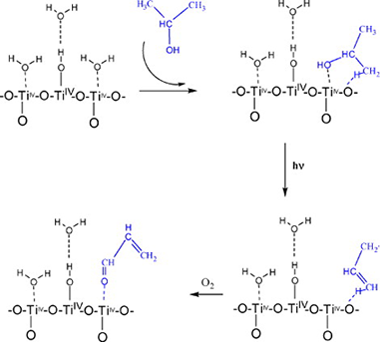
Abstract
The photocatalytic efficiency of different TiO 2 catalysts in the degradation of 2-propanol in gas phase has been studied. The obtained efficiencies have been compared considering the distribution of rutile-anatase phases, surface area, particle size, distribution of surface hydroxyl groups and Brönsted or Lewis acid centres. The catalysts used were Degussa-P25 (TiO 2-P25), Hombikat, Millennium, Kemira and s/g-TiO 2, a catalyst prepared by a sol-gel method. The best photocatalytic behaviours have been obtained with those catalysts with higher surface area and the presence of only anatase phase (Hombikat and Millennium). A progressive deactivation of TiO 2-P25 and s/g-TiO 2 has been observed during the photocatalytic process. FTIR studies indicated that degradation mechanisms depended on the catalyst employed. Deactivation processes observed in TiO 2-P25 have been correlated with the formation of carboxylates.
July, 2009 · DOI: 10.1016/j.apcatb.2008.11.027
Fotocatálisis Heterogénea: Aplicaciones
Degradation of n-Butyl tin Chlorides in Waters. A Comparative Assessment of the Process by Photo-assisted and Chemical- treatment Methods
Navio, JA; Cerrillos, C; Macias, MJournal of Advanced Oxidation Technologies, 12 (2009) 158-163 DOI: ---
Study of degradation processes of metals used in some artworks from the cultural heritage of Andalusia, Spain
Duran, A; Herrera, LK; de Haro, MCJ; Perez-Rodriguez, JL; Justo, ARevista de Metalurgia, 45 (2009) 277-286 DOI: 10.3989/revmetalm.0827
Abstract
The study of the alteration processes of metals, such as lead, bronze, iron and tin-mercury alloys, used in some of the
most important chosen artefacts of Andalusian Cultural Heritage is the main objective of this paper. Hydrocerussite
and cerussite were detected in lead seals stored in a hole of cardboard. Bronze is altered to atacamite by environmental
contamination, which is also responsible for the formation of rust from iron. Corrosion of the tin-mercury surface
of amalgam mirrors produces tin monoxide and tin dioxide and releases liquid mercury from the solid phase.
July, 2009 · DOI: 10.3989/revmetalm.0827
Materiales de Diseño para la Energía y Medioambiente
Stability of phyllosilicates in Ca(OH)2 solution: Influence of layer nature, octahedral occupation, presence of tetrahedral Al and degree of crystallinity
Mantovani, M; Escudero, A; Alba, MD; Becerro, AIApplied Geochemistry, 24 (2009) 1251-1260 DOI: 10.1016/j.apgeochem.2009.03.012
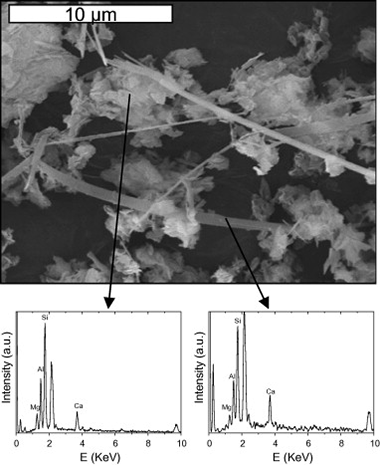
Abstract
This paper presents the results of a comprehensive investigation of the interaction of layered silicates with Ca(OH)2 in hydrothermal conditions. The study is intended to evaluate the stability of the clay buffer in radioactive waste repositories, at the intermediate stages of concrete leaching, when the pH is controlled by the dissolution of portlandite. The influence of layer nature, octahedral occupation, presence of tetrahedral Al and degree of crystallinity will be assessed by analysing the behaviour of a set of well-selected phyllosilicates and using the combined capabilities of 29Si and 27Al MAS-NMR spectroscopy, powder X-ray diffraction and SEM/EDX. The results show that the main factor affecting the stability of the clay is the octahedral occupation, so that trioctahedral phyllosilicates are much more stable than dioctahedral ones. The nature and expandability of the layer does not seem to much influence the stability of the clay, so that a 2:1 expandable phyllosilicate shows the same stability as a chemically analogous 1:1 non-expandable phyllosilicate. However other factors like the poor crystallinity of the starting material or the presence of Al in the tetrahedral sheet of trioctahedral phyllosilicates weaken the clay structure in alkaline conditions and favour the transformation towards other phases.
July, 2009 · DOI: 10.1016/j.apgeochem.2009.03.012
Study of the gilding technique used in polychromed stones and ceramics by dedicated laboratory-made micro X-ray diffraction and complementary techniques
Duran, A; Perez-Rodriguez, JL; de Haro, MCJAnalytical and Bioanalytical Chemistry, 394 (2009) 1671-1677 DOI: 10.1007/s00216-009-2836-3
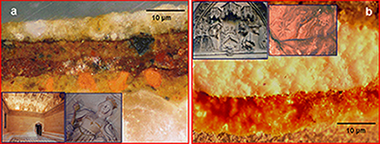
Abstract
This work describes the use of a new dedicated laboratory-made micro X-ray diffraction system for detecting the phases present in cross-sections of artworks. As an example, the phases present in samples from gilding ceramics and stone sculptures from the heritage of Seville (Spain) were successfully detected using this new system, which takes advantage of various devices developed for synchrotron radiation, and is complemented by the information provided by other techniques.
July, 2009 · DOI: 10.1007/s00216-009-2836-3
Materiales Ópticos Multifuncionales
Light generation at the anomalous dispersion high energy range of a nonlinear opal film
Botey, M; Maymo, M; Molinos-Gomez, A; Dorado, L; Depine, RA; Lozano, G; Mihi, A; Miguez, H; Martorell, JOptics Express, 17 (2009) 12210-12216 DOI: 10.1364/OE.17.012210
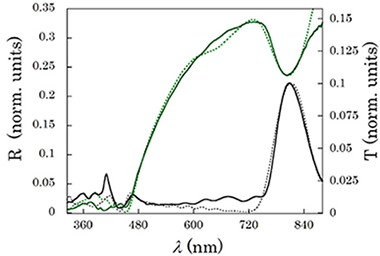
Abstract
We study experimentally and theoretically light propagation and generation at the high energy range of a close-packed fcc photonic crystal of polystyrene spheres coated with a nonlinear material. We observe an enhancement of the second harmonic generation of light that may be explained on the basis of amplification effects arising from propagation at anomalous group velocities. Theoretical calculations are performed to support this assumption. The vector KKR method we use allows us to determine, from the linear response of the crystal, the behavior of the group velocity in our finite photonic structures when losses introduced by absorption or scattering by defects are taken into account assuming a nonzero imaginary part for the dielectric constant. In such structures, we predict large variations of the group velocity for wavelengths on the order or smaller than the lattice constant of the structure, where an anomalous group velocity behavior is associated with the flat bands of the photonic band structure. We find that a direct relation may be established between the group velocity reduction and the enhancement of a light generation processes such as the second harmonic generation we consider. However, frequencies for which the enhancement is found, in the finite photonic crystals we use, do not necessarily coincide with the frequencies of flat high energy bands.
July, 2009 · DOI: 10.1364/OE.17.012210
Reactividad de Sólidos
A recurrent error which needs to be resolved
Ortega, AThermochimica Acta, 491 (2009) 116-117 DOI: 10.1016/j.tca.2009.02.009
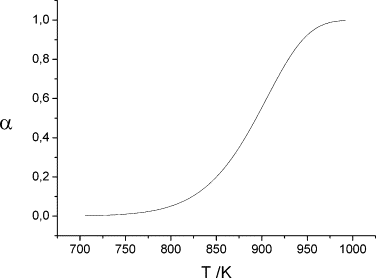
Abstract
The recent paper by Jankovic et al. [B. Janković, B. Adnađevic, J. Jovanović; Thermochimica Acta 452 (2007) 106] and other similar papers have raised a problem which needs to be resolved. These authors use the method of Kennedy and Clark [J.A. Kennedy, S.M. Clark, Thermochimica Acta 307 (1997) 27] which is conceptually erroneous; this is analyzed in this paper.
July, 2009 · DOI: 10.1016/j.tca.2009.02.009
Fotocatálisis Heterogénea: Aplicaciones
Effect of Sulfate Pretreatment on Gold-Modified TiO2 for Photocatalytic Applications
Hidalgo, MC; Maicu, M; Navio, JA; Colon, GJournal of Physical Chemistry C, 113 (2009) 12840-12847 DOI: 10.1021/jp903432p

Abstract
The influence of sulfated pretreatment of TiO2 on the structure, morphology, and dispersion of gold and photocatalytic properties of Au/TiO2 were studied. Notable enhancements in the photocatalytic activity of TiO2 were achieved by deposition of gold onto samples that had previously undergone sulfate treatment followed by high temperature calcination. The enhancement in activity can be attributed to the stronger bonding and improved electronic communication between gold particles and TiO2 on defect rich surfaces as are found on sulfated samples after calcination at 700 °C. Two different methods for gold deposition were evaluated: chemical reduction by citrate and photodeposition. The citrate method produced more homogeneous and smaller gold particles with a better dispersion than photodeposition, which lead to greater increases in activity in the photocatalytic degradation of phenol when the former method was used for deposition on both sulfated and nonsulfated TiO2. The combination of sulfate pretreatment and gold deposition by chemical reduction was shown to be a good strategy to obtain gold/titania catalysts possessing homogeneous particle size and dispersion of the metal and a strong bonding between the Au and the TiO2 surface.
July, 2009 · DOI: 10.1021/jp903432p
Fotocatálisis Heterogénea: Aplicaciones
ZnO activation by using activated carbon as a support: Characterisation and photoreactivity
Melian, EP; Diaz, OG; Rodriguez, JMD; Colon, G; Arana, J; Melian, JH; Navio, JA; Pena, JPApplied Catalysis A-General, 364 (2009) 176-181 DOI: 10.1016/j.apcata.2009.05.042

Abstract
The effect of the mixing ZnO with different portions of activated carbon (AC) has been studied. The resulting catalysts were characterised and evaluated in the photocatalytic decomposition of aqueous pollutants. Changes in the catalyst colour and in the FTIR vibration bands of the surface hydroxyl groups were recorded. νOH vibrations were shifted to lower wavenumbers as AC loading increased, demonstrating modification of the acid-base character of the catalysts. Laser scattering studies showed that AC loading leads to smaller ZnO particles. BET surface area measurements and scanning electron micrograph (SEM) analysis showed agglomeration of ZnO particle pores in the AC structure.
Results showed that in addition to a synergistic effect of the AC-ZnO combination, AC content modifies the ZnO particle properties and consequently photocatalytic behaviour. This was evident in phenol degradation experiments where changes in the concentration profiles of the catechol and hydroquinone degradation intermediates, were observed. However, the AC-ZnO catalysts were less efficient than pure ZnO in the degradation of 2,4-dichlorophenol (DCP). This seems to be due to the strong adsorption of the DCP molecule on AC, resulting in lower diffusion to the catalytic ZnO and thus a lower rate of photocatalysis.
July, 2009 · DOI: 10.1016/j.apcata.2009.05.042
Nanotecnología en Superficies y Plasma
Electrical characteristics of mixed Zr–Si oxide thin films prepared by ion beam induced chemical vapor deposition at room temperature
Ferrer, FJ; Frutos, F; Garcia-Lopez, J; Jimenez, C; Yubero, FThin Solid Films, 517 (2009) 5446-5452 DOI: 10.1016/j.tsf.2009.01.099
Abstract
Mixed Zr–Si oxide thin films have been prepared at room temperature by ion beam decomposition of organometallic volatile precursors. The films were flat and amorphous. They did not present phase segregation of the pure single oxides. A significant amount of impurities (–C–, –CHx, –OH, and other radicals coming from partially decomposed precursors) remained incorporated in the films after the deposition process. This effect is minimized if the Ar content in the O2/Ar bombarding gas is maximized. Static permittivity and breakdown electrical field of the films were determined by capacitance–voltage and current–voltage electrical measurements. It is found that the static permittivity increases non-linearly from ~ 4 for pure SiO2 to ~ 15 for pure ZrO2. Most of the dielectric failures in the films were due to extrinsic breakdown failures. The maximum breakdown electrical field decreases from ~ 10.5 MV/cm for pure SiO2 to ~ 45 MV/cm for pure ZrO2. These characteristics are justified by high impurity content of the thin films. In addition, the analysis of the conduction mechanisms in the formed dielectrics is consistent to Schottky and Poole-Frenkel emission for low and high electric fields applied, respectively.
July, 2009 · DOI: 10.1016/j.tsf.2009.01.099
Nanotecnología en Superficies y Plasma
Nanoindentation of TiO2 thin films with different microstructures
Gaillard, Y; Rico, VJ; Jimenez-Pique, E; Gonzalez-Elipe, ARJournal of Physics D: Applied Physics, 42 (2009) 145305 DOI: 10.1088/0022-3727/42/14/145305
Abstract
A series of nanoindentation tests has been carried out with TiO2 films produced by physical vapour deposition (PVD) under different conditions. Films with different microstructures and crystallographic structures have been prepared by changing experimental parameters such as the temperature of the substrate, the deposition angle (by the so-called glancing angle physical vapour deposition, GAPVD) or by exposing the growing film to a beam of accelerated ions. The obtained results of hardness and Young's modulus depict interesting correlations with the microstructure and structure of the films providing a general picture for the relationships between these characteristics and their mechanical properties. Different models have been used to extract Young's modulus and hardness parameters from the experimental nanoindentation curves. The obtained results are critically discussed to ascertain the ranges of validity of each procedure according to the type of sample investigated.
July, 2009 · DOI: 10.1088/0022-3727/42/14/145305
Nanotecnología en Superficies y Plasma
Chemical State of Nitrogen and Visible Surface and Schottky Barrier Driven Photoactivities of N-Doped TiO2 Thin Films
Romero-Gomez, P; Rico, V; Borras, A; Barranco, A; Espinos, JP; Cotrino, J; Gonzalez-Elipe, ARJournal of Physical Chemistry C, 113 (2009) 13341-13351 DOI: 10.1021/jp9024816

Abstract
N-doped TiO2 thin films have been prepared by plasma enhanced chemical vapor deposition and by physical vapor deposition by adding nitrogen or ammonia to the gas phase. Different sets of N-doped TiO2 thin films have been obtained by changing the preparation conditions during the deposition. The samples have been characterized by X-ray diffraction, Raman, UV−vis spectroscopy, and X-ray photoemission spectroscopy (XPS). By changing the preparation conditions, different structures, microstructures, and degrees and types of doping have been obtained and some relationships have been established between these film properties and their visible light photoactivity. The N1s XP spectra of the samples are characterized by three main features, one tentatively attributed to Ti−N (i.e., nitride with a binding energy (BE) of 396.1 eV) and two others with BEs of 399.3 and 400.7 eV, tentatively attributed to nitrogen bonded simultaneously to titanium and oxygen atoms (i.e., Ti−N−O like species). By controlling the deposition conditions it is possible to prepare samples with only one of these species as majority component. It has been shown that only the samples with Ti−N−O like species show surface photoactivity being able to change their wetting angle when they are illuminated with visible light. The presence of these species and an additional complex structure formed by a mixture of anatase and rutile phases is an additional condition that is fulfilled by the thin films that also present photocatalytic activity with visible light (i.e., surface and Schottky barrier driven photoactivities). The relationships existing between the reduction state of the samples and the formation of Ti−N or Ti−N−O like species are also discussed.
July, 2009 · DOI: 10.1021/jp9024816
Química de Superficies y Catálisis
Deposition of Al-Fe pillared bentonites and gold supported Al-Fe pillared bentonites on metallic monoliths for catalytic oxidation reactions
Martinez, LM; Dominguez, MI; Sanabria, N; Hernandez, WY; Moreno, S; Molina, R; Odriozola, JA; Centeno, MAApplied Catalysis A-General, 364 (2009) 166-173 DOI: 10.1016/j.apcata.2009.05.046

Abstract
Al-Fe pillared bentonite and gold supported on Al-Fe pillared bentonite catalysts deposed on Fecralloy monoliths have been prepared, characterized and tested in two oxidation reactions: gaseous oxidation of CO and phenol oxidation in aqueous medium. The deposition of the solid on the metallic substrate does not alter its structural characteristics. The use of monoliths improves the activity in both reactions and offers the additional advantage to facilitate the separation of the catalyst from the reaction medium.
July, 2009 · DOI: 10.1016/j.apcata.2009.05.046
Materiales Coloidales
M-Doped Al2TiO5 (M=Cr, Mn, Co) Solid Solutions and their Use as Ceramic Pigments
Dondi, M; Lyubenova, TS; Carda, JB; Ocaña, MJournal of the American Ceramic Society, 92 (2009) 1972-1980 DOI: 10.1111/j.1551-2916.2009.03172.x
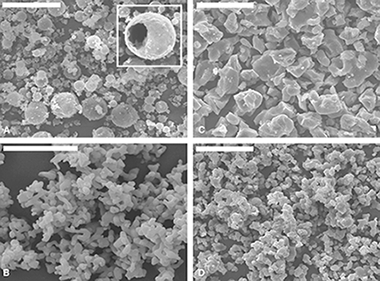
Abstract
New ceramic pigments based on the tialite (Al2TiO5) structure, doped with Co (pink), Cr (green), or Mn (brown), were prepared through the pyrolysis of aerosols followed by calcination of the obtained powders at 1400°C. The expected decomposition of Al2TiO5 into a mixture of Al2O3 and TiO2 on refiring was inhibited by Cr-doping and also by co-doping with Mg the Mn- or Co-doped samples. Microstructure and phase evolution during pigment preparation were monitored by scanning electron microscopy and XRPD. Unit cell parameters of tialite were determined by Rietveld refinement of the X-ray diffraction patterns, revealing in all cases the formation of solid solutions where the solubility of dopants in the Al2TiO5 lattice followed the trend Co<Mn<Cr. The valence state and possible location of dopants in the tialite lattice were investigated by X-ray photoelectron spectra and diffuse reflectance spectroscopies, which suggested the presence of Cr3+ ions in a large interstitial site of the tialite lattice with a distorted octahedral geometry, and of Mn3+ and Co2+ ions in the Al3+ octahedral sites of the tialite lattice in the former case, and in both Al3+ and Ti4+ octahedral sites in the latter. Testing the ceramic glazes assessed the technological behavior of pigments, which found that the color stability was reasonably good for the Mn-doped tialite and the Cr-doped pigment, although the latter suffered a small loss of green hue. The Co-doped pigment was found to be not stable in glazes, undergoing a cobalt-leaching effect.
June, 2009 · DOI: 10.1111/j.1551-2916.2009.03172.x
Materiales de Diseño para la Energía y Medioambiente
Chemical Reactions in 2D: Self-Assembly and Self-Esterification of 9(10),16-Dihydroxypalmitic Acid on Mica Surface
Heredia-Guerrero, JA; San-Miguel, MA; Sansom, MSP; Heredia, A; Benitez, JJLangmuir, 25 (2009) 6869-6874 DOI: 10.1021/la9001412
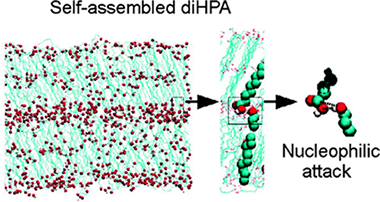
Abstract
9(10),16-Dihydroxypalmitic acid (diHPA) is a particularly interesting polyhydroxylated fatty acid (1) because it is the main monomer of cutin, the most abundant biopolyester in nature, and (2) because the presence of a terminal and a secondary hydroxyl group in midchain positions provides an excellent model to study their intermolecular interactions in a confined phase such as self-assembled layers. In this study we have combined atomic force microscopy (AFM), X-ray photoelectron spectroscopy (XPS), attenuated total reflection Fourier transform infrared (ATR-FT-IR) spectroscopy, as well as molecular dynamics (MD) simulations to conclude that the self-assembling of diHPA molecules on mica is a layer by layer process following a Brunauer−Emmett−Teller (BET) type isotherm and with the first layer growing much faster than the rest. Interactions between secondary hydroxyls reinforce the cohesive energy of the monolayer, while the presence of the terminal hydroxyl group is necessary to trigger the multilayered growth. Besides, XPS and ATR-FT-IR spectroscopies clearly indicate that spontaneous self-esterification occurs upon self-assembling. The esterification reaction is a prerequisite to propose a self-assembly route for the biosynthesis of cutin in nature. Molecular dynamics simulations have shown that internal molecular reorganization within the self-assembled layers provides the appropriate intermolecular orientation to facilitate the nucleophilic attack and the release of a water molecule required by the esterification reaction.
June, 2009 · DOI: 10.1021/la9001412
Materiales Nanoestructurados y Microestructura
Thermal Evolution of WC/C Nanostructured Coatings by Raman and In Situ XRD Analysis
El Mrabet, S; Abad, MD; Lopez-Cartes, C; Martinez-Martinez, D; Sanchez-Lopez, JCPlasma Processes and Polymers, 6 (2009) S444-S449 DOI: 10.1002/ppap.200931004

Abstract
In this work, a series of WC/C nanostructured films were deposited on silicon substrates by changing the ratio of sputtering power applied to graphite and WC magnetron sources (PC/PWC: 0, 0.1, 0.5, 1). The thermal stability of WC/C coatings was followed in situ by means of X-ray diffraction measurements up to 1 100 °C in vacuum (10−1 Pa). Initially, the film microstructure is composed of nanocrystalline WC1−x and W2C phases. As the PC/PWC ratio increases the crystallinity decreases, and WC1−x becomes the predominant phase from PC/PWC = 0.1. The results show that the structural evolution with temperature of all studied layers depends essentially on their initial phase and chemical composition (determined by the synthesis conditions: ratio PC/PWC). The coating deposited at PC/PWC = 0 reveals a transformation of W2C phase into W and W3C phases at 400 °C. However, the samples with PC/PWC greater than 0 exhibits an improved thermal stability up to 600–700 °C where the WC1−x begins to transform into W2C and WC phases. At 900 °C, WC is the predominant phase, especially for those coatings prepared with higher ratios. Further annealing above 1 000 °C yields W as the foremost phase. The thermal behaviour was later studied by means of Raman spectroscopy measurements at certain temperatures where the main changes in phase composition were observed. Particularly, a fitting analysis was carried out on the D and G bands typical of disordered and amorphous carbon. The changes induced during heating are discussed in terms of the positions of D and G lines, and full width at half maximum (FWHM).
June, 2009 · DOI: 10.1002/ppap.200931004
Materiales de Diseño para la Energía y Medioambiente
Application of 29Si and 27Al MAS NMR Spectroscopy to the Study of the Reaction Mechanism of Kaolinite to Illite/Muscovite
Mantovani, M; Escudero, A; Becerro, AIClays and Clay Minerals, 57 (2009) 302-310 DOI: 10.1346/CCMN.2009.0570303
Abstract
Understanding the mechanisms for illitization of clay minerals has important applications in reconstructing geologic histories and determining the origins of physical and chemical characteristics of buried sediments. While many studies have been carried out on this topic, few have focused on the mechanism of illite formation from kaolinite. The purpose of this study was to investigate more deeply the illitization of kaolinite in KOH solution at a high solid/liquid ratio (1000 mg/mL). X-ray diffraction (XRD) and infrared spectroscopy were used to follow the formation of new crystalline phases and the composition of the octahedral sheet, while the transformation of the Si and Al local environments was analyzed by 29Si and 27Al magic angle spinning nuclear magnetic resonance spectroscopy (MAS NMR). The results revealed that the first reaction stage consists of the diffusion of Al from the octahedral to the tetrahedral sheet of the kaolinite TO layers, giving rise to the precursors of the illite/muscovite nuclei. Combination of XRD with 27Al MAS NMR measurements indicated that a minimum amount of tetrahedral Al is required in the original TO layer before condensation of a second tetrahedral sheet occurs to complete the formation of the illite/muscovite TOT layers.
June, 2009 · DOI: 10.1346/CCMN.2009.0570303
Química de Superficies y Catálisis
Determination of nitrogen partitioning coefficients in superduplex stainless steels by NRA using a nuclear microprobe
Munoz, C; Morilla, Y; Lopez, JG; Paul, A; Odriozola, JANuclear Instruments and Methods in Physics Research Section B: Beam Interactions with Materials and Atoms, 267 (2009) 2208-2211 DOI: 10.1016/j.nimb.2009.03.093

Abstract
Superduplex stainless steels (SDSSs) combine the good mechanical behavior and the high corrosion resistance of the ferrite (α-Fe) and austenite (γ-Fe) phases. The SDSSs properties depend strongly on the partitioning of the elements that form the alloy. The ferrite is generally enriched in P, Si, Cr and Mo while the content of Ni, Mn, Cu and N in the austenite phase is higher. Nitrogen is known to be a strong austenite stabilizer and its presence increases the strength and the pitting corrosion resistance of the stainless steels. While the global nitrogen content in SDSSs can be readily determined using elemental analyzers, it cannot be measured at a microscopic scale.
In this work, the nuclear microprobe of the Centro Nacional de Aceleradores (Sevilla) was used to obtain the quantitative distribution of nitrogen in SDSSs. A deuteron beam of 1.8 MeV was employed to determine the overall elemental concentration of the matrix by deuteron-induced X-ray emission, whereas the nitrogen partitioning coefficients were obtained by using the 14N(d, α0)12C nuclear reaction. Mappings of this element show that the nitrogen ratio between the ferrite and austenite phases ranges from 0.3 to 0.6 in the analyzed samples.
June, 2009 · DOI: 10.1016/j.nimb.2009.03.093
Materiales Avanzados
Phyllites used as waterproofing layer materials for greenhouses crops in Spain: multivariate statistical analysis applied to their classification based on X-ray fluorescence analysis
Garzon, E; Garcia-Rodriguez, IG; Ruiz-Conde, A; Sanchez-Soto, PJX-Ray Spectrometry, 38 (2009) 429-438 DOI: 10.1002/xrs.1199
Abstract
The results are presented for the chemical characterization carried out with 53 raw material samples with phyllosilicates from outcrops located between the provinces of Almería and Granada (SE Spain) in order to use them as waterproof layers under the floors of greenhouses. For this purpose, the samples have been studied by these techniques: X-Ray Diffraction (XRD), X-Ray Fluorescence (WDXRF), Scanning Electron Microscopy (SEM), chemical analysis by energy-dispersive X-Ray detection (EDX), and thermogravimetry. To isolate groups of phyllite samples with similar chemical profiles and correlations between the samples, the WDXRF data (11 chemical elements) have been processed using the methodology of exploratory multivariate statistical analyses: cluster analysis, main-component analysis, and discriminating canon analysis. This study was performed as a screening test and as a means of finding similarities and correlations among all 53 phyllite samples, allowing the isolation of groups of phyllite samples with similar chemical profiles. The results indicate that the 53 phyllite samples can be divided into two main groups. The first group is subdivided into two subgroups (1 and 2), one of which includes most of the samples. The latter is further classified into three blocks with the same chemical composition. This allows to search for the raw material with potentially the best waterproof characteristics within the five groups. The classification is of validity as a screening test for subsequent experimental determinations concerning the physical properties of these samples.
June, 2009 · DOI: 10.1002/xrs.1199
Química de Superficies y Catálisis
Fibrous MnO2 Nanoparticles with (2 × 2) Tunnel Structures. Catalytic Activity in the Total Oxidation of Volatile Organic Compounds
Dominguez, MI; Navarro, P; Romero-Sarria, F; Frias, D; Cruz, SA; Delgado, JJ; Centeno, MA; Montes, M; Odriozola, JAJournal of Nanoscience and Nanotechnology, 9 (2009) 3837-3842 DOI: 10.1166/jnn.2009.NS76
Abstract
Manganese oxides having 2 × 2 tunnel structures (cryptomelanes) have been synthesized by a milling method in order to test their efficiency as catalysts for the abatement of volatile organic compounds, using toluene as probe molecule. These materials present excellent textural properties, arising from the nanofiber morphology and were active for toluene total oxidation. DRIFTS of the adsorbed phase allow proposing the role of lattice oxygen in the catalytic reaction.
June, 2009 · DOI: 10.1166/jnn.2009.NS76
Nanotecnología en Superficies y Plasma
Growth of Crystalline TiO2 by Plasma Enhanced Chemical Vapor Deposition
Borras, A; Sanchez-Valencia, JR; Widmer, R; Rico, VJ; Justo, A; Gonzalez-Elipe, ARCrystal Growth & Design, 9 (2009) 2868-2876 DOI: 10.1021/cg9001779
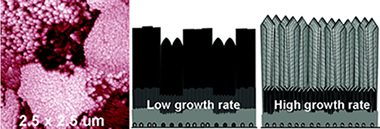
Abstract
TiO2 thin films in the form of anatase have been prepared by plasma enhanced chemical vapor deposition (PECVD) at 523 K as the substrate temperature and a low working pressure. The study of the microstructure and texture of the films at different stages of deposition show that their growth follows the Kolmogorov’s model developed to describe the evolution of crystalline films from a saturated homogeneous medium. An additional characteristic feature of the growth process by PECVD is the formation of different crystalline domains, particularly at low deposition rates. The effects of this parameter and of the characteristics of the substrate on the growing process are also addressed.
June, 2009 · DOI: 10.1021/cg9001779
Química de Superficies y Catálisis
Integration of methanol steam reforming and combustion in a microchannel reactor for H2 production: A CFD simulation study
Arzamendi, G; Dieguez, PM; Montes, M; Centeno, MA; Odriozola, JA; Gandia, LMCatalysis Today, 143 (2009) 25-31 DOI: 10.1016/j.cattod.2008.09.034

Abstract
A computational fluid dynamics (CFD) study of the thermal integration of the steam reforming of methanol (SRM) and the combustion of methanol in a catalytic microchannel reactor is presented. This issue is of interest for in situ H2 production for portable power units based on low-temperature PEM fuel cells. Three-dimensional simulations have been carried out under relevant conditions for the SRM reaction that have shown that microreactors allow achieving complete methanol reforming and combustion at space velocities as high as 50,000 h−1, with selectivities for H2 above 99% at relatively low temperatures in the 270–290 °C range.
May, 2009 · DOI: 10.1016/j.cattod.2008.09.034
Fotocatálisis Heterogénea: Aplicaciones
Cationic (V, Mo, Nb, W) doping of TiO2–anatase: A real alternative for visible light-driven photocatalysts
Kubacka, A; Colon, G; Fernandez-Garcia, MCatalysis Today, 143 (2009) 286-292 DOI: 10.1016/j.cattod.2008.09.028

Abstract
In this article we investigate the structure–activity link of anatase-type Ti–M (M = V, Mo, Nb, and W) mixed oxides used for toluene photo-oxidation under sunlight-type excitation. An analysis of the local and long-range structural and electronic characteristics of the mixed oxides show that only structurally highly homogeneous anatase-type oxides with electronic properties exclusively leading to a band gap decrease drive to efficient visible light-driven photocatalysts. Within our microemulsion preparation method, this only occurs for Ti–V and Ti–W series of samples. The isoelectronic (V4+) substitution of Ti4+ ions at the anatase lattice is characterized by a low solubility limit (ca. 2.5 at. %), and drives to a limited modification of the band gap and to a moderate enhancement of the photo-activity with respect to bare titania reference systems. W presence at anatase cation positions occurs with concomitant presence of cation vacancies derived by the charge imbalance between the W6+ and Ti4+ species. A unique W-vacancy local arrangement is detected by the structural characterization, leading to both an important band gap decrease and enhancement of the photo-activity upon sunlight excitation.
May, 2009 · DOI: 10.1016/j.cattod.2008.09.028
Nanotecnología en Superficies y Plasma
Wetting angles and photocatalytic activities of illuminated TiO2 thin films
Rico, V; Romero, P; Hueso, JL; Espinos, JP; Gonzalez-Elipe, ARCatalysis Today, 143 (2009) 347-354 DOI: 10.1016/j.cattod.2008.09.037

Abstract
TiO2 thin films have been prepared by physical vapour deposition (PVD) and plasma enhanced chemical vapour deposition (PECVD) to study the UV-induced photo-activity of this material. Wetting angle variations and photo-catalytic activity for the degradation of dyes upon UV illumination have been compared for thin films with different crystalline structure (amorphous, rutile and anatase), microstructure (columnar, compact, etc.) and porosities as estimated from the values of their refraction indices and their direct assessment with a quartz crystal monitor. The surface of the thin films became superhydrophilic upon UV light irradiation and then it recovered its original state by keeping the samples in the dark. Wetting angle decays follow very similar kinetics for amorphous and crystalline films, independently of their actual porosities. By contrast the photo-catalytic activity was very dependent on the crystalline structure of the films (anatase > rutile > amorphous) and on their porosities. The different behaviour depicted by the films with regard to these two properties suggests that they respond to different though related mechanisms and that they cannot be considered as equivalent when trying to prove the photo-activity of TiO2.
May, 2009 · DOI: 10.1016/j.cattod.2008.09.037
- ‹ previous
- 35 of 37
- next ›














